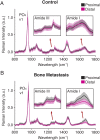Multiscale characterization of the mineral phase at skeletal sites of breast cancer metastasis
- PMID: 28923958
- PMCID: PMC5635895
- DOI: 10.1073/pnas.1708161114
Multiscale characterization of the mineral phase at skeletal sites of breast cancer metastasis
Abstract
Skeletal metastases, the leading cause of death in advanced breast cancer patients, depend on tumor cell interactions with the mineralized bone extracellular matrix. Bone mineral is largely composed of hydroxyapatite (HA) nanocrystals with physicochemical properties that vary significantly by anatomical location, age, and pathology. However, it remains unclear whether bone regions typically targeted by metastatic breast cancer feature distinct HA materials properties. Here we combined high-resolution X-ray scattering analysis with large-area Raman imaging, backscattered electron microscopy, histopathology, and microcomputed tomography to characterize HA in mouse models of advanced breast cancer in relevant skeletal locations. The proximal tibial metaphysis served as a common metastatic site in our studies; we identified that in disease-free bones this skeletal region contained smaller and less-oriented HA nanocrystals relative to ones that constitute the diaphysis. We further observed that osteolytic bone metastasis led to a decrease in HA nanocrystal size and perfection in remnant metaphyseal trabecular bone. Interestingly, in a model of localized breast cancer, metaphyseal HA nanocrystals were also smaller and less perfect than in corresponding bone in disease-free controls. Collectively, these results suggest that skeletal sites prone to tumor cell dissemination contain less-mature HA (i.e., smaller, less-perfect, and less-oriented crystals) and that primary tumors can further increase HA immaturity even before secondary tumor formation, mimicking alterations present during tibial metastasis. Engineered tumor models recapitulating these spatiotemporal dynamics will permit assessing the functional relevance of the detected changes to the progression and treatment of breast cancer bone metastasis.
Keywords: Raman imaging; X-ray scattering; bone metastasis; bone mineral nanostructure; breast cancer.
Conflict of interest statement
The authors declare no conflict of interest.
Figures














Similar articles
-
Hydroxyapatite nanoparticle-containing scaffolds for the study of breast cancer bone metastasis.Biomaterials. 2011 Aug;32(22):5112-22. doi: 10.1016/j.biomaterials.2011.03.055. Epub 2011 Apr 20. Biomaterials. 2011. PMID: 21507478 Free PMC article.
-
In vivo tibial compression decreases osteolysis and tumor formation in a human metastatic breast cancer model.J Bone Miner Res. 2013 Nov;28(11):2357-67. doi: 10.1002/jbmr.1966. J Bone Miner Res. 2013. PMID: 23649605 Free PMC article.
-
Inhibition by interleukin 18 of osteolytic bone metastasis by human breast cancer cells.Anticancer Res. 1999 Sep-Oct;19(5B):4131-8. Anticancer Res. 1999. PMID: 10628364
-
Breast cancer-derived factors facilitate osteolytic bone metastasis.Bull Cancer. 2006 Sep;93(9):931-43. Bull Cancer. 2006. PMID: 16980236 Review.
-
Mouse models of breast cancer metastasis to bone.Cancer Metastasis Rev. 2012 Dec;31(3-4):579-83. doi: 10.1007/s10555-012-9378-4. Cancer Metastasis Rev. 2012. PMID: 22706780 Review.
Cited by
-
The osteogenic niche-targeted arsenic nanoparticles prevent colonization of disseminated breast tumor cells in the bone.Acta Pharm Sin B. 2022 Jan;12(1):364-377. doi: 10.1016/j.apsb.2021.06.012. Epub 2021 Jun 21. Acta Pharm Sin B. 2022. PMID: 35127392 Free PMC article.
-
Enhancement of the therapeutic efficacy of the MAP regimen using thiamine pyrophosphate-decorated albumin nanoclusters in osteosarcoma treatment.Bioeng Transl Med. 2022 Dec 26;8(6):e10472. doi: 10.1002/btm2.10472. eCollection 2023 Nov. Bioeng Transl Med. 2022. PMID: 38023714 Free PMC article.
-
Temporal and spatial changes in bone mineral content and mechanical properties during breast-cancer bone metastases.Bone Rep. 2022 Jun 12;17:101597. doi: 10.1016/j.bonr.2022.101597. eCollection 2022 Dec. Bone Rep. 2022. PMID: 35754558 Free PMC article.
-
From breast cancer cell homing to the onset of early bone metastasis: The role of bone (re)modeling in early lesion formation.Sci Adv. 2024 Feb 23;10(8):eadj0975. doi: 10.1126/sciadv.adj0975. Epub 2024 Feb 21. Sci Adv. 2024. PMID: 38381833 Free PMC article.
-
Top-down Fabrication of Spatially Controlled Mineral-Gradient Scaffolds for Interfacial Tissue Engineering.ACS Biomater Sci Eng. 2019 Jun 10;5(6):2988-2997. doi: 10.1021/acsbiomaterials.9b00176. Epub 2019 May 7. ACS Biomater Sci Eng. 2019. PMID: 31211246 Free PMC article.
References
-
- Kozlow W, Guise TA. Breast cancer metastasis to bone: Mechanisms of osteolysis and implications for therapy. J Mammary Gland Biol Neoplasia. 2005;10:169–180. - PubMed
-
- Fratzl P, Gupta HS, Paschalis EP, Roschger P. Structure and mechanical quality of the collagen-mineral nano-composite in bone. J Mater Chem. 2004;14:2115–2123.
Publication types
MeSH terms
Substances
Grants and funding
LinkOut - more resources
Full Text Sources
Other Literature Sources
Medical
Molecular Biology Databases

